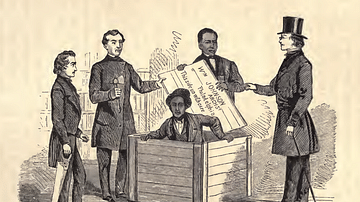Review

| Rating: | |
|---|---|
| Title: | The United States Governed by Six Hundred Thousand Despots: A True Story of Slavery; A Rediscovered Narrative, with a Full Biography |
| Author: | John Swanson Swanson Jacobs & Jonathan D. S. Schroeder |
| Audience: | University |
| Difficulty: | Medium |
| Publisher: | University of Chicago Press |
| Published: | 2024 |
| Pages: | 327 |
"The United States Governed by Six Hundred Thousand Despots: A True Story of Slavery" presents readers with a largely unknown narrative written by John Swanson Jacobs, a formerly enslaved man, a biography of him, and other documents about his life. By making Jacobs’s narrative accessible and available, this volume will help scholars learn more about the global dimensions of slave narratives. This book is well-suited for both scholars and students and is highly recommended.
Discovering forgotten or overlooked sources is always exciting. Jonathan D. S. Schroeder recently rediscovered John Swanson Jacobs’s narrative The United States Governed by Six Hundred Thousand Despots: A True Story of Slavery. Jacobs’s narrative, which had been published in an Australian newspaper in 1855, had been largely forgotten. Narratives published about slavery, captivity, and freedom are important primary sources for scholars. This narrative, which Schroeder correctly labels a global slave narrative, promises to help increase scholarly understandings of slavery and freedom in the Americas.
The volume contains three distinct sections. The first section is the narrative itself, which appears as it was published, albeit with minor corrections, extensive explanatory footnotes, and an introduction from Schroeder. Jacobs was the brother of Harriet Jacobs, the author of another famous narrative. Harriet Jacobs’s narrative, Incidents in the Life of Slave Girl (1861), was published under a pseudonym and heavily edited by white abolitionist Lydia Maria Child. John Jacobs’s narrative, on the other hand, was not subject to any editing by white abolitionists and appeared in an Australian newspaper, which spoke to how Jacobs’s life transcended the borders of the United States. Jacobs took to the sea and, like many other Black sailors, saw himself as a cosmopolitan and the world as his country. Jacobs’s narrative is well worth reading and Schroeder details how Jacobs challenged many of the conventions of enslaved narratives. In the first part of the narrative, Jacobs described his life, his enslaver’s relentless pursuit of Harriet, and his eventual escape to freedom. The second part foregrounded his stinging denunciation of U.S. law and politics, which, he contended, supported and reinforced slavery. He frequently called out specific politicians and correctly depicted Washington, D.C. as a city where slave traders sold human beings and politicians gambled rather than made laws. Interestingly, in light of the recent discussion about 1619 vs. 1776, Jacobs mentioned another date entirely—1522. His use of 1522 should remind readers that slavery did not begin in the Americas in 1619 and that it had existed for more than a century when the first enslaved people were brought to what is now the United States. “The history of the global slave narrative has yet to be told,” (xxx). Schroeder correctly concludes. Jacobs’s narrative will help scholars begin to tell this important story.
The second section of the book is an extended biography of Jacobs, written by Schroeder. Here Schroeder illustrates, in clear detail and powerful prose, Jacobs’s riveting life story. Schroder deftly illuminates Jacobs’s life, noting that he and Harriet “were born into an age of rebellion, and into a family that had resisted slavery for over a century” (80). Schroeder traces their family, explores how both siblings escaped slavery, their lives in the northern states, and John’s decision to leave the United States and relocate first to Australia and later to England. “Through courage, intelligence, and patience, he had walked away from slavery and social death and forged life after life—mariner, abolitionist, miner, husband, father” (178). Jacobs eventually returned to the U.S. in 1873 and died at the end of that year. He is buried in the Jacobs family plot at Mount Auburn Cemetery, but, until recently, his grave marker had sunk underground. “The burial and resurfacing of John Jacobs’s grave marker is an apt symbol for his disappearance from historical memory—and the work that remains to be done to resurrect him” (181). Schroeder also includes a fascinating discussion of why he believes the portrait long known as "The Man Holding the Liberator" (1848) is actually a portrait of Jacobs. The third section of the book contains an array of useful primary sources—both documents written by Jacobs and documents written about him.
Jonathan D. S. Schroeder, currently a Lecturer at the Rhode Island School of Design, recently rediscovered John Swanson Jacobs’s narrative The United States Governed by Six Hundred Thousand Despots: A True Story of Slavery. This book will appeal to anyone interested in learning more about slavery and freedom in the 19th-century world. It will work especially well in classes about historical methods as well as many other upper-level undergraduate courses and graduate classes.
About the Reviewer
Cite This Work
APA Style
Rothera, E. (2025, January 22). The United States Governed by Six Hundred Thousand Despots: A True Story of Slavery; A Rediscovered Narrative, with a Full Biography. World History Encyclopedia. Retrieved from https://www.worldhistory.org/review/507/the-united-states-governed-by-six-hundred-thousand/
Chicago Style
Rothera, Evan. "The United States Governed by Six Hundred Thousand Despots: A True Story of Slavery; A Rediscovered Narrative, with a Full Biography." World History Encyclopedia. Last modified January 22, 2025. https://www.worldhistory.org/review/507/the-united-states-governed-by-six-hundred-thousand/.
MLA Style
Rothera, Evan. "The United States Governed by Six Hundred Thousand Despots: A True Story of Slavery; A Rediscovered Narrative, with a Full Biography." World History Encyclopedia. World History Encyclopedia, 22 Jan 2025, https://www.worldhistory.org/review/507/the-united-states-governed-by-six-hundred-thousand/. Web. 23 Apr 2025.




